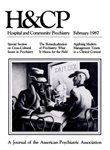Structural Inefficiencies at a State Psychiatric Hospital
Abstract
This case study of structural inefficiencies in a state psychiatric hospital illustrates that careful analysis of problems, innovative thinking, clear understanding of the hospital's mission, and the use of modern technology can bring about improved patient care and substantial cost containment. While no two state hospitals have identical problems, we believe that the principles described here may well be applied to many state facilities throughout the country.
An intangible but critical factor underlying inefficiencies was a pervasive and persistent mindset at all staff levels that change was impossible, inferior standards inveitable, and "the state" immovable and impenetrable. Thus change in the hospital was resisted at all levels. Reasons most often heard were that "patient care will suffer," "we don't have enough staff," "it costs too much," and "we tried that before, and it didn't work."
Solutions to this problem are difficult to describe in concrete terms. We see interpersonal communication between the superintendent and staff at all levels as the best way to clarify the need for change and to implement it, and indeed the ideas of staff are an essential input in the formation of new plans. Regularly scheduled meetings with the medical staff, nurses, and unit directors were extremely helpful in improving morale as well as bringing about needed change. The superintendent's frequent informal rounds of the wards on all shifts allowed face-to-face communication with ward staff (and patients) and a realistic appraisal of the performance of the various departments.
Nothing succeeds like success, and after some early changes produced visible results, it became easier to implement others. A very few middle-level managers proved unwilling or unable to change, and if they were actually impeding hospital improvement, they were demoted or dismissed.
The hospital administration was extremely fortunate that the state legislature was an active partner in the hospital's attempt to achieve efficiencies and improve services. Individual members and legislative committees were immensely interested in and supportive of their efforts. On its part, the hospital administration frequently invited legislators to visit the hospital and shared with them the difficulties and attempts to achieve cost containment and improve care. Thus, an adversarial relationship was turned around, and successful cooperation was obtained.
A crucial factor in the achievement of change was budgetary flexibility. The fiscal Committee, which understood the game plan, allowed the hospital to transfer some savings achieved from one budget line to cover increasing costs in another. In this way, cost savings and improved care went hand in hand.
Currently 1,100 employees serve 500 patients. The reduction of staff by 200 saved approximately $3.2 million annually, and energy savings totaled $1.9 million. Increased revenues included $80,000 rent for the power plant, $300,000 from the special school, and $1.2 million in federal funds for the ICF/MR. Over a three-year perid, the hospital donated $2 million per annum to community mental health centers and supplied trained clinical staff to start up four new community residences.
The hospital was surveyed by JCAH in 1985 and received a full three-year accreditation, demonstrating that effective management addresses patient care needs along with financial accountability.
Access content
To read the fulltext, please use one of the options below to sign in or purchase access.- Personal login
- Institutional Login
- Sign in via OpenAthens
- Register for access
-
Please login/register if you wish to pair your device and check access availability.
Not a subscriber?
PsychiatryOnline subscription options offer access to the DSM-5 library, books, journals, CME, and patient resources. This all-in-one virtual library provides psychiatrists and mental health professionals with key resources for diagnosis, treatment, research, and professional development.
Need more help? PsychiatryOnline Customer Service may be reached by emailing [email protected] or by calling 800-368-5777 (in the U.S.) or 703-907-7322 (outside the U.S.).



